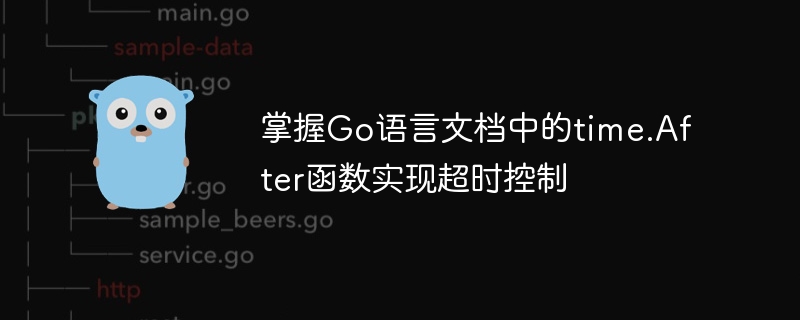 Backend Development
Backend Development
 Golang
Golang
 Master the time.After function in Go language documentation to implement timeout control
Master the time.After function in Go language documentation to implement timeout control
Master the time.After function in Go language documentation to implement timeout control

To master the time.After function in the Go language document to implement timeout control, specific code examples are needed
Go language is a simple and efficient programming language, which has Concurrent programming capabilities. In concurrent programming, we often encounter scenarios where timeouts need to be controlled to prevent the program from blocking forever.
The time package is provided in the standard library of Go language. There is a very useful function in this package called After. The After function returns a channel that receives a value of type time.Time after the specified time interval. We can use this function to implement timeout control.
The following is a sample code that demonstrates how to use the time.After function to implement timeout control:
package main
import (
"fmt"
"time"
)
func main() {
// 创建一个通道,用于接收超时信号
timeout := make(chan bool, 1)
// 启动一个goroutine,等待指定的时间后向timeout通道发送超时信号
go func() {
time.Sleep(2 * time.Second)
timeout <- true
}()
// 阻塞等待timeout通道的消息,如果超过指定的时间则执行超时逻辑
select {
case <-timeout:
fmt.Println("请求超时")
case <-time.After(1 * time.Second):
fmt.Println("请求处理中...")
// 这里可以编写请求处理的逻辑
}
}In this example, we use the time.After function to create a 1-second timer . If no timeout signal is received from the timeout channel within 1 second, the logic in the channel returned by the time.After function will be executed.
If a timeout signal is received within 1 second, the logic in the timeout channel will be executed and a "request timeout" prompt will be printed.
In this way, we can use the time.After function to implement a simple timeout control. In actual development, we can adjust and set an appropriate timeout as needed.
To summarize, mastering the time.After function in the Go language document can help us achieve timeout control. By setting the timeout reasonably, we can avoid the program from blocking forever and improve the robustness and stability of the system.
The above is the detailed content of Master the time.After function in Go language documentation to implement timeout control. For more information, please follow other related articles on the PHP Chinese website!

Hot AI Tools

Undresser.AI Undress
AI-powered app for creating realistic nude photos

AI Clothes Remover
Online AI tool for removing clothes from photos.

Undress AI Tool
Undress images for free

Clothoff.io
AI clothes remover

AI Hentai Generator
Generate AI Hentai for free.

Hot Article

Hot Tools

Notepad++7.3.1
Easy-to-use and free code editor

SublimeText3 Chinese version
Chinese version, very easy to use

Zend Studio 13.0.1
Powerful PHP integrated development environment

Dreamweaver CS6
Visual web development tools

SublimeText3 Mac version
God-level code editing software (SublimeText3)

Hot Topics
 1359
1359
 52
52
 What libraries are used for floating point number operations in Go?
Apr 02, 2025 pm 02:06 PM
What libraries are used for floating point number operations in Go?
Apr 02, 2025 pm 02:06 PM
The library used for floating-point number operation in Go language introduces how to ensure the accuracy is...
 Which libraries in Go are developed by large companies or provided by well-known open source projects?
Apr 02, 2025 pm 04:12 PM
Which libraries in Go are developed by large companies or provided by well-known open source projects?
Apr 02, 2025 pm 04:12 PM
Which libraries in Go are developed by large companies or well-known open source projects? When programming in Go, developers often encounter some common needs, ...
 What is the problem with Queue thread in Go's crawler Colly?
Apr 02, 2025 pm 02:09 PM
What is the problem with Queue thread in Go's crawler Colly?
Apr 02, 2025 pm 02:09 PM
Queue threading problem in Go crawler Colly explores the problem of using the Colly crawler library in Go language, developers often encounter problems with threads and request queues. �...
 In Go, why does printing strings with Println and string() functions have different effects?
Apr 02, 2025 pm 02:03 PM
In Go, why does printing strings with Println and string() functions have different effects?
Apr 02, 2025 pm 02:03 PM
The difference between string printing in Go language: The difference in the effect of using Println and string() functions is in Go...
 Why is it necessary to pass pointers when using Go and viper libraries?
Apr 02, 2025 pm 04:00 PM
Why is it necessary to pass pointers when using Go and viper libraries?
Apr 02, 2025 pm 04:00 PM
Go pointer syntax and addressing problems in the use of viper library When programming in Go language, it is crucial to understand the syntax and usage of pointers, especially in...
 How to solve the user_id type conversion problem when using Redis Stream to implement message queues in Go language?
Apr 02, 2025 pm 04:54 PM
How to solve the user_id type conversion problem when using Redis Stream to implement message queues in Go language?
Apr 02, 2025 pm 04:54 PM
The problem of using RedisStream to implement message queues in Go language is using Go language and Redis...
 Why do all values become the last element when using for range in Go language to traverse slices and store maps?
Apr 02, 2025 pm 04:09 PM
Why do all values become the last element when using for range in Go language to traverse slices and store maps?
Apr 02, 2025 pm 04:09 PM
Why does map iteration in Go cause all values to become the last element? In Go language, when faced with some interview questions, you often encounter maps...
 What is the difference between `var` and `type` keyword definition structure in Go language?
Apr 02, 2025 pm 12:57 PM
What is the difference between `var` and `type` keyword definition structure in Go language?
Apr 02, 2025 pm 12:57 PM
Two ways to define structures in Go language: the difference between var and type keywords. When defining structures, Go language often sees two different ways of writing: First...



